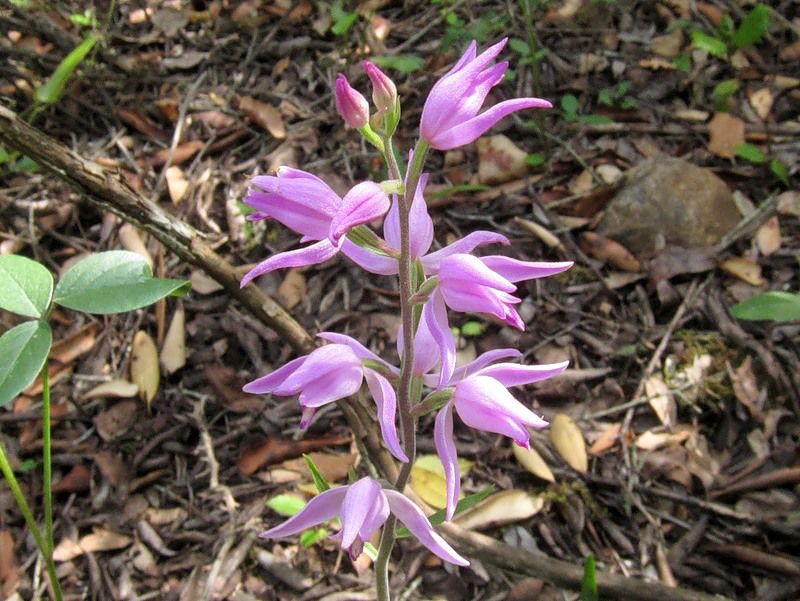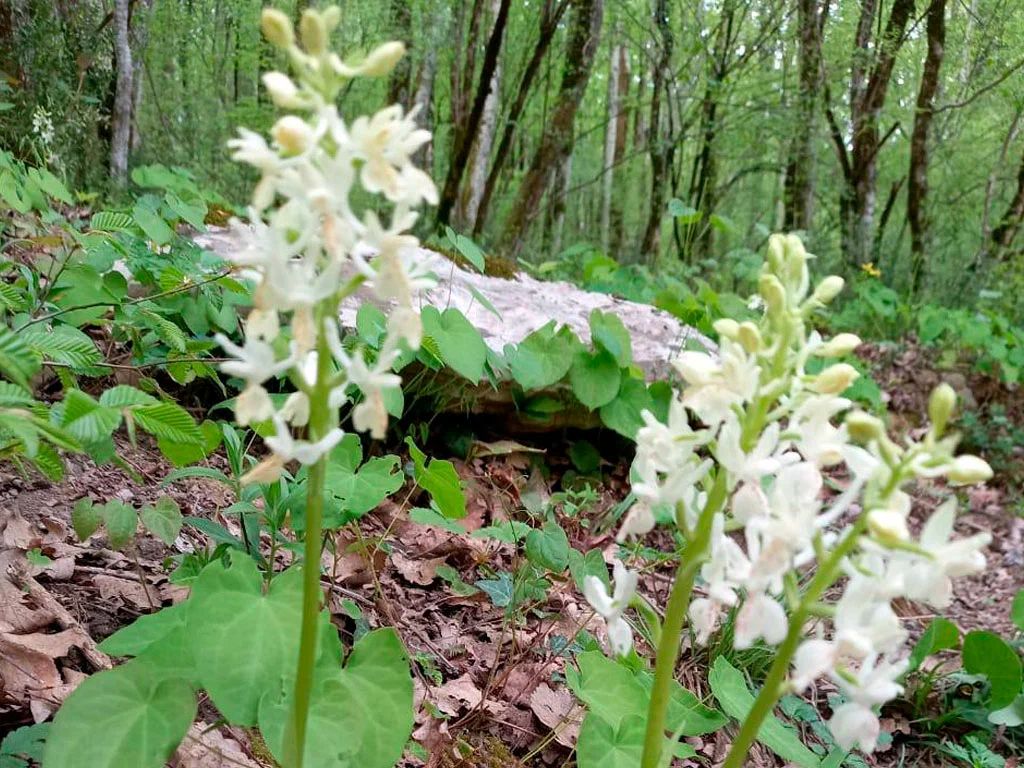

The climate of Sochi is subtropical and there is a large number of exotic rare plants, unique endemic trees and flowers. Orchids are unusual flowers and also are typical of the southern tropical flora. The orchid family arose 130 million years ago, South America is considered to be the birthplace of these flowers and its tropical climate is good for their flowering. Over time, the orchids appeared in Europe when they were brought there from the Bahama Islands. Today, one can see orchids in the wild not only in part of the European continent, but also in Russia, in particular, in the Caucasus. In total, there are about 750 genera in the orchid family, including 25 thousand species. There are 62 species in the Caucasus, 49 species in the North-Western Caucasus, 46 species of wild orchids in the city of Sochi. Of course, the orchids that grow in Russia are not as beautiful as those in tropical countries, but the unique features of exotic orchids in Russia lie in the variety of shapes and colors. At the same time, the number of orchid varieties in Russia is negligible, and most of the species, especially the ones growing in Sochi, like phantom orchids, early marsh orchids, ghost orchids, helleborines, rattlesnake plantains, rein orchises, twayblades, bird’s-nest orchids, orchises, butterfly orchids, traunsteineras, coralroots, and others, are listed in the Red Data Book (Endangered Species List). Scientists do their best to save them today.
According to the Ministry of Natural Resources of the Krasnodar Territory, there are 82 specially protected areas in Sochi. Five of them are of federal significance, 71 are natural monuments of regional significance, as well as an ornithological park in the Imereti Lowlands, and five more protected areas are of local significance. According to the regional authorities, the Red Data Book plant species, including orchids, are protected, any withdrawal from their natural environment is possible only with a special permit and compensatory measures should be taken. In addition, the Ministry of Natural Resources of the Krasnodar Territory warns that the destruction of rare endangered species is punishable by law, including a criminal liability.
However, according to Elena Averyanova, Candidate of Biological Sciences, a member of the Academic Council of the Sochi Geographical Society, despite the legislation regulating the use of green pieces of land in specially protected natural areas, the problem with rare orchids in Sochi is very acute because the exotic flowers are endangered due to active development of infrastructure in the resort city. In particular, this includes the construction of houses in the areas where orchids grow, usually the places of high, middle, and low mountains. The geography of wild-growing orchids in the resort city is quite wide - from the Sochi National Park to the lands of the forest fund. This becomes the main problem threatening a significant reduction in exotic flowers and can result in their complete destruction. Rare Red Data Book’s orchids are increasingly cut down. The city is growing, people choose places to live in the mountains, the boundaries of the urban area are expanding, which cannot but affect the local flora and fauna. The ecologists in Sochi are concerned about 32 types of decorative flowers growing on the edges of forests and in the lower mountain areas, in those places where houses or other objects are mainly built that destroy rare flowers.
“Orchids are very rare plants, they are usually listed in the Red Data Book, and they are gradually disappearing, their populations are decreasing because our city is developing very fast, the infrastructure is growing, settlements are being built, and these areas inhabited by these orchids were the border of the forest. Orchids are under threat, some populations have already died as a result of construction, expansion of roads, and so on,” Averyanova said.
In her opinion, to solve the problem of declining number of orchids, the land areas in Sochi where exotic flowers grow, must be given a protected status, then it will be much more difficult to cut down the plants. According to Averyanova, the procedure for creating specially protected natural areas is initiated by the scientists who discover rare plant species in the resort city. In addition, the expert notes that it should be forbidden to build capital buildings in protected natural areas, which will protect the flowers from external impacts.
Sochi ecologist Yulia Naberezhnaya offers a similar way to preserve rare flowers. According to her, work on determining the lands that could get a specially protected status is carried out systematically and regularly, but it takes a lot of time since the process requires the coordination with experts, scientists, city and regional administrations.
In turn, Alexander Zobnin, Chairman of the Geographical Society, notes that the procedure for assigning specially protected area status to lands is quite complicated and not always mandatory. To give an area such a status, at first, it is necessary to obtain the consent of a land owner, and only if there are no problems with the land allocation, no land owner’s objections, the environmentalists can recommend creating a specially protected natural area on the site where rare flowers grow.
Another way to preserve orchids is breeding wild orchids in a laboratory, in vitro, says Elena Averyanova, Candidate of Biological Sciences, member of the Academic Council of the Sochi Geographical Society. To do this, certain types of orchids are grown in test tubes, planted in a pot in greenhouses, and ‘repatriated’ to nature. But, in order for them to be planted in nature and preserved, it is necessary to prepare areas for this, and there are no such areas in Sochi. Another problem for breeding wild orchids in the laboratory, according to Averyanova, is the lack of equipment. This was the reason that scientists have not yet achieved the expected results. Moreover, as the expert notes, orchids grow better in their natural environment, which is why it is so important to protect them from building houses and destroying today instead of breeding them.
When asked what measures to preserve rare exotic flowers are taken by the authorities today, the Kuban Ministry of Natural Resources explained that specialists are carrying out monitoring work and take measures to preserve exotic flowers. However, the situation with the destruction of orchids in the resort city causes concern among environmentalists.
“The number of orchids of our regions is really decreasing, this is confirmed by many years of scientific observations. The most important and effective thing is to preserve the natural complexes of plants, animals, microorganisms, their environment in places where orchids grow,” concluded Elena Averyanova, Candidate of Biological Sciences, member of the Academic Council of the Sochi Geographical Society.

Not only orchids suffer
The destruction of orchids is not the only problem in the Sochi ecosystem. The process of chestnut trees’ death, for example, is influenced by a biological factor - the chestnut gall wasps that kill chestnut trees. According to Sochi environmentalist Yulia Naberezhnaya, the situation with chestnut trees today is critical. As the scientist notes, the death of the plants is exacerbated by a concomitant bacterial disease of the trees - endothium cancer, due to which chestnut forests in the Sochi National Park and the Caucasian Biosphere Reserve are on the verge of extinction. Their loss has rather serious impact, since it is a food base for animals living in these places.
“This is a big problem that can be solved only at the state level. Theoretically, the area of damaged chestnut forests increases every year,” Naberezhnaya said.
The absence of chestnut trees can also lead to the complete disappearance of delicious chestnut honey that was once famous for its unusual taste.
“In 2023 the chestnut content in honey was very low,” said Ekaterina Voznyukova, Director of the Sochi Branch of the Federal State Budget Scientific Institution of the Federal Scientific Center for Beekeeping.
In addition to the chestnut gall wasps, which has long been doing harm to chestnut forests, there is a new threat in Sochi - lace bugs. For the first time, scientists recorded a problem in the Krasnodar Territory in 2017. The homeland of lace-bugs is North America and it is still difficult to find out where lace bugs came to the Kuban from. But there are a lot of insects in the south and they continue damaging oak forests in the region. The problem gets further aggravated because every year, the lace bugs increase their distribution area. According to the forecasts of the Ministry of Natural Resources of the Krasnodar Territory, it can cover absolutely all the oak forests of the region.
The Sochi environmentalists do their best to preserve the local flora and agree that only assigning a special status to lands can save the nature, this will also protect green spaces from numerous development projects. In the fight against invasive pests, experts do not rule out the use of more progressive methods, since insects that destroy the oaks of the region and the Sochi chestnut trees create a critical situation in the ecosphere.
